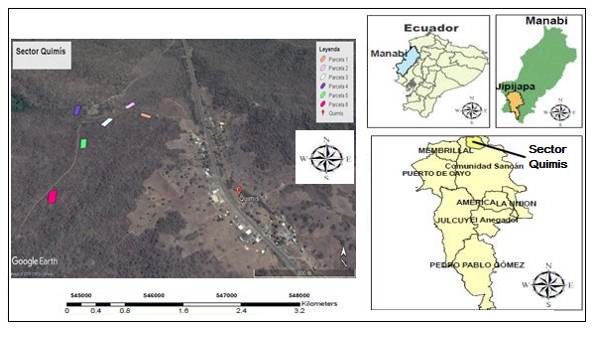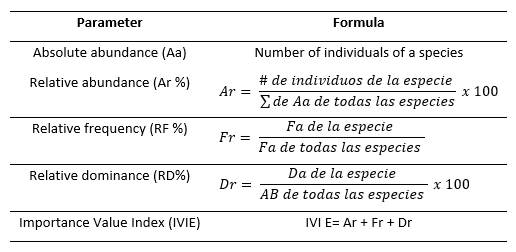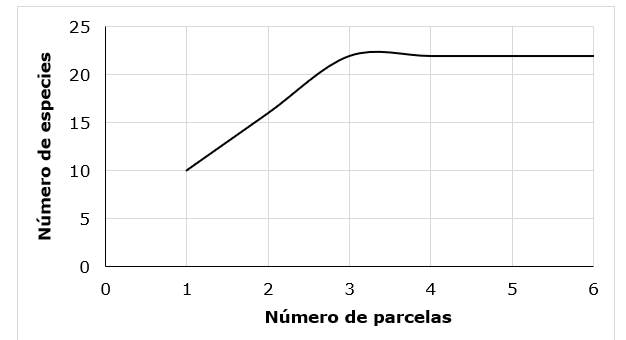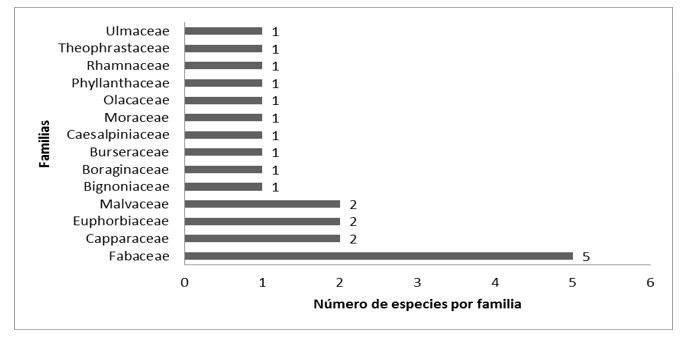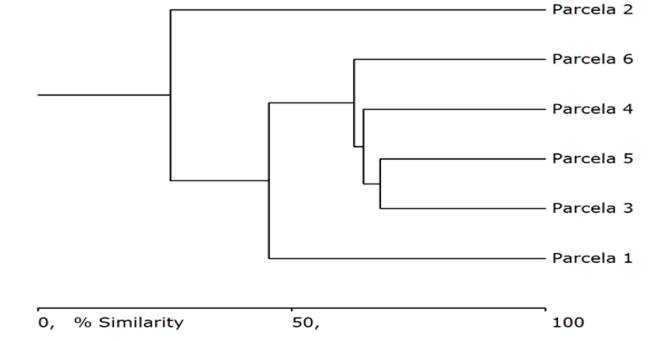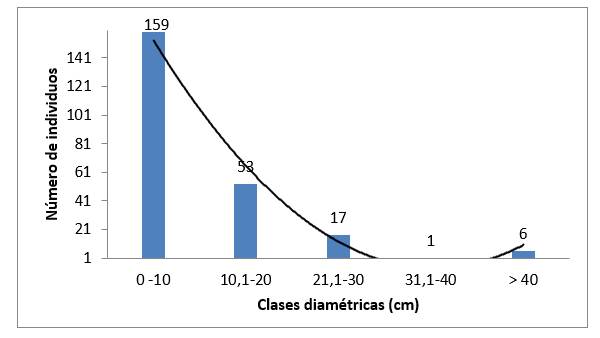Mi SciELO
Servicios Personalizados
Articulo
Indicadores
-
 Citado por SciELO
Citado por SciELO
Links relacionados
-
 Similares en
SciELO
Similares en
SciELO
Compartir
Revista Cubana de Ciencias Forestales
versión On-line ISSN 2310-3469
Rev cubana ciencias forestales vol.10 no.2 Pinar del Río mayo.-ago. 2022 Epub 02-Ago-2022
Original article
Structure and tree composition on the tropical dry forest in Sancán valley, Manabí, Ecuador
1Universidad Estatal del Sur de Manabí, Ecuador.
The tropical dry forest is a forest formation that requires greater knowledge of its dynamics and structure for management and conservation. In order to generate information on a dry forest remnant of the Sancán area, the floristic composition and structure of this was evaluated. Six sampling parcels settled down with a surface of 1 000 m2 (20 × 50 m); the diameter (D1.30) and height of all individuals e" 5 cm were recorded. Floristic composition, Shannon and Simpson index, abundance, frequency, dominance and importance value index were determined; and diametric structure was calculated. A total of 236 individuals, 21 species within 20 genera in 14 families were recorder. The families with the highest number of species were: Fabaceae, Malvaceae and, Euphorbiaceae; the most ecologically important species were: Ceiba trichistandra, Bursera graveolens and Geoffroea spinosa. According to the Shannon index, diversity is high (3.83). The diameter distribution of the individuals presented an inverted "J" pattern, indicating that the forest still conserves elements in its composition and structure from the original. The species found are representative of the dry forest with anthropic intervention of selective use and without technical planning.
Key words: Diversity; Dry Forest; Horizontal structure; Diameter structure.
INTRODUCTION
Deforestation, worldwide, is one of the processes of environmental degradation with a high negative impact on the sustainability and competitiveness of ecosystems. It generates losses of biodiversity and degradation of soils and waters. Not only changes the microclimates of the affected regions but also the climate globally. Despite the fact that deforestation has decreased in the last 25 years, forests are still being deforested worldwide (FAO 2018).
Currently, the recovery of forested areas, the reduction of logging and adequate forest management have become priority activities to restore forests, the biodiversity they harbor and the environmental services they provide, as a strategy to face the effects of climate change (Aitken et al., 2008; Aguirre-Mendoza et al., 2021c; Bautista-Miranda 2019).
Ecuador is a country rich in natural resources, with climatic and biological diversity such as tropical and Andean forests (Rosillo et al., 2020). These are considered fragile ecosystems and vulnerable to the combined effects of climate change, deforestation and degradation (Aguirre-Mendoza et al., 2017). At the same time, they have the potential to help mitigate climate change, restore ecosystem functions, and provide environmental goods and services (Herzog et al., 2013).
Studies in this Ecuadorian formation show high floristic diversity of these forests, their great heterogeneity, differences in the current species composition due to human influence and fragmentation (Aguirre-Mendoza et al., 2017; Aguirre-Mendoza et al., 2018).
This study was carried out with the purpose of evaluating the floristic and structural composition of the tropical dry forest of the Sancán Valley to provide elements that allow improving the management and conservation actions of the remaining dry forest.
MATERIALS AND METHODS
Study area and sampling sites
The study was carried out in the Quimis sector, Sancán valley belonging to the Jipijapa canton, located in the south of the Manabí province. It limits to the North with the La Pila parish, to the South with the Sancán community, to the East with the Cerrito la Asunción and to the West with the Membrillal parish (Figure 1). The climate is warm dry with a temperature between 21 to 37 0C and the annual rainfall average is 600 mm. The soils are clayey, on average slopes of 80 %. Lowland deciduous forest and semi-deciduous low montane and/or foot montane forest predominate in this region (Aguirre-Mendoza et al., 2021c).
In the study area, six sampling plots with a surface of 1 000 m2 (20×50 m) were established, validated by means of the species accumulation curve. For the establishment, a compass, a GPS, stakes and string were used. All individuals of tree species greater than 5 cm in diameter (D1.30) were recorded. The species and the number of trees of each individual were identified and the total height (h) and diameter (D1.30) were measured. The registration and collection of woody individuals followed the methodology of Phillips et al. (2016).
Analysis of data
Floristic composition
During the collection of information in the field, botanical material was collected from all existing tree species in the sampling sites. The botanical samples of all the individuals were identified in the ECUAMZ herbarium (Amazonian Herbarium of Ecuador) of the Amazon Postgraduate Research and Conservation Center (CIPCA) of the Amazon State University. The nomenclature of scientific names follows the APG IV system.
Alpha and beta diversity indices
In order to measure the tree diversity of the forest, the Shannon-Weaver diversity index (H') was estimated, which expresses the heterogeneity of a community; and the Simpson diversity index (1/D), which estimates whether a given community is made up of species with great dominance (Aguirre-Mendoza et al., 2021). To evaluate the beta diversity of the forest, a conglomerate of analysis was performed to detect similarities between plots. These analyzes were performed with the BioDiversity Pro program ver. 2.0.
Calculation of structural parameters
The ecological importance index (IVIE) of eachspecies was calculated, which relates the relative abundance (Ar), relative frequency (Fr) and relative dominance (Dr) (Manzanilla et al., 2020) (Table 1).
Diametric structure
The diameter structure of the forest was determined considering the number of individuals with D1.30 cm ≥ 5 cm and belonging to the diameter classes established by Aguirre-Mendoza et al. (2017) based on determining the diameter distribution of the vegetation.
RESULTS AND DISCUSSION
The species accumulation curve indicates that the number of sampled plots was sufficient to represent the floristic richness of the forest (Figure 2).
Floristic composition
In the study, 21 species, 20 genera, 14 families and a total of 236 individuals were recorded, results similar to those reported by Jiménez et al. (2021) who reported 31 species, 29 genera and 16 families in seven active apiaries distributed within the Quimís enclosure, and very different from what was reported by Maldonado et al. (2018) in a tropical montane forest that found 81 tree species.
Within the identified species, Pithecellobium arboreum is classified as Vulnerable (VU) and Croton rivinifolius Endangered (EN) according to the IUCN Red Book (IUCN, 2020), meaning it has a high risk of extinction in nature. In this sense, both species face a risk of extinction or population deterioration in the medium term.
The species Colicodendron scabridum and Bursera graveolens, according to the IUCN Red Book, are categorized as least concern (LC), that is, they are not critically endangered, similar to Ceiba trichistandra. The latter being the most used by the surrounding communities.
The families with the greatest diversity of species were: Fabaceae with five species, Capparaceae, Euphorbiaceae and Malvaceae with two, and the rest of the families represented by a single species (Figure 3), results similar to those reported by Aguirre et al. (2021a) who register: Fabaceae, Asteraceae, Malvaceae and Rubiaceae as the families with the greatest diversity of species in the dry forest of the "El Tabanco" sector, Mangahurco parish, Zapotillo, Ecuador. Likewise, Jiménez et al. (2021) report the families Fabaceae, Ericaceae and Malvaceae as the most diverse. According to these studies, the outstanding families in dry forests are: Fabaceae and Malvaceae.
Structural parameters
The species with the greatest presence in the forest were Bursera graveolens, Geoffroea spinosa and Jacquinia sprucei , which also coincide with the most abundant. Ceiba trichistandra, Jacquinia sprucei, and Bursera graveolens were the most frequent species in the forest, while Ceiba trichistandra, Bursera graveolens, and Geoffroea spinosa were the dominant species.
The species with the highest importance value were Ceiba trichistandra with 33.16 %, Bursera graveolens with 11.46 % and Geoffroea spinosa with 6.99 % (Table 2), this result is similar to the one was observed by Aguirre et al. (2021c) who also report Ceiba trichistandra as an outstanding species. In the same way, Jiménez et al. (2019) indicate that Ceiba trichistandra is the most important and that it is a typical and characteristic species of the dry forests of Ecuador and Peru, compared to other dry forests in the world.
On the other hand, it was observed that among the species with the lowest IVIE are Machaerium millei with 0.85 % and Croton rivinifolius and Pithecellobium excelsum with 0.71 % each, different results from those reported by Aguirre et al. (2021b) indicating Gynoxys nitida, Piper ecuadorense and Meliosma arenosa as species with lower IVIE in the Huashapamba forest, Loja, Ecuador; to Aguirre et al. (2021c) in Zapotepamba where the ecologically least important species was Melinis minutiflora. While in the permanent plot of the dry forest in the El Tabanco sector, Mangahurco, Ecuador, the ecologically less important species are Machaerium millei and Terminalia valverdae(Aguirre et al., 2021a). The difference found is possibly due to the degree of anthropic intervention and maturity of the vegetation.
Table 2. - Structural parameters of the 10 main species of the tree component of the tropical dry forest of the Quimís sector, Sancán Valley
| Species | AA | RA (%) | FA | RF (%) | GIVES | RD (%) | IVIE (%) |
|---|---|---|---|---|---|---|---|
|
|
eleven | 4.66 | 6 | 10.00 | 13.61 | 84.82 | 33.16 |
|
|
47 | 19.91 | 5 | 8.33 | 0.99 | 6.14 | 11.46 |
|
|
25 | 10.59 | 5 | 8.33 | 0.29 | 1.84 | 6.92 |
|
|
9.75 | 6 | 10 | 0.10 | 0.62 | 6.79 | |
|
|
19 | 8.05 | 5 | 8.33 | 0.10 | 0.63 | 5.67 |
|
|
16 | 6.78 | 5 | 8.33 | 0.08 | 0.47 | 5.19 |
|
|
17 | 7.20 | 4 | 6.67 | 0.26 | 1.63 | 5.17 |
|
|
18 | 7.63 | 4 | 6.67 | 0.07 | 0.45 | 4.92 |
|
|
10 | 4.24 | 4 | 6.67 | 0.08 | 0.49 | 3.80 |
|
|
9 | 3.81 | 3 | 5.00 | 0.06 | 0.40 | 3.06 |
AA: Absolute Abundance, FA: Absolute Frequency, DA: Absolute Dominance, AR: Relative Abundance, FR: Relative Frequency, DR: Relative Dominance, IVIE: Ecological Importance Value Index.
Shannon index (H) and Simpson's reciprocal (1/D)
According to the results, the diversity of species according to the Shannon index is classified as high diversity in the area of the Quimís sector, evidenced by the result obtained H=3.83. In this sense, the Bursera graveolens species stand out, while Croton rivinifolius and Pithecellobium excelsum present low diversity in the study area (Table 3). The results of the reciprocal of Simpson Dominance (1/D) = 0.06 and Simpson (D) =0.91 show a high expectation to make a random selection of two or more individuals of the same species in the established research area.
Similar results were reported by Aguirre-Mendoza et al. (2017), in the southwest of Ecuador, who reported a value of 2.51, which indicates a medium diversity. In the same way, the Simpson index showed a high dominance (S=0.93); similar to that reported by a study of the floristic composition and structure of dry forests in the province of Loja, Ecuador (Aguirre et al., 2013) who reported a high dominance (S = 0.89).
Table 3. - Shannon diversity index of the study species of the tropical dry forest in the Quimís sector, Sancán Valley
| Species (Scientific name) | Ind by sp. | AR "PI" | Ln "PI" | PI*Ln (PI) | PI* Ln(PI)*-1 |
| 47 | 0.20 | -2.33 | -0.46 | 0.46 | |
| 25 | 0.11 | -3.24 | -0.34 | 0.34 | |
| 0.10 | -3.36 | -0.33 | 0.33 | ||
| 19 | 0.08 | -3.63 | -0.29 | 0.29 | |
| 18 | 0.08 | -3.71 | -0.28 | 0.28 | |
| 17 | 0.07 | -3.80 | -0.27 | 0.27 | |
| 16 | 0.07 | -3.88 | -0.26 | 0.26 | |
| eleven | 0.05 | -4.42 | -0.21 | 0.21 | |
| 10 | 0.04 | -4.56 | -0.19 | 0.19 | |
| 9 | 0.04 | -4.71 | -0.18 | 0.18 | |
| 7 | 0.03 | -5.08 | -0.15 | 0.15 | |
| 6 | 0.03 | -5.30 | -0.13 | 0.13 | |
| 5 | 0.02 | -5.56 | -0.12 | 0.12 | |
| 5 | 0.02 | -5.56 | -0.12 | 0.12 | |
| 5 | 0.02 | -5.56 | -0.12 | 0.12 | |
| 4 | 0.02 | -5.88 | -0.10 | 0.10 | |
| 3 | 0.01 | -6.30 | -0.08 | 0.08 | |
| two | 0.01 | -6.88 | -0.06 | 0.06 | |
| two | 0.01 | -6.88 | -0.06 | 0.06 | |
| 1 | 0.00 | -7.88 | -0.03 | 0.03 | |
| 1 | 0.00 | -7.88 | -0.03 | 0.03 | |
| Total | 236 | 1 | -106.4 | -3.83 | 3.83 |
Ind by sp. = number of individuals per species in the six plots; AR= relative abundance; PI= proportion of the number of individuals of species i with respect to the total; Ln= natural logarithm.
Beta diversity
The dendrogram derived from the Bray-Curtis similarity-dissimilarity matrix (1957) (Figure 4) groups the study plots into three well-defined sets. In group one is plot 1, group two is made up of plots 3, 5, 4 and 6, and group three is made up of plot 2. The groupings are influenced by the number of individuals of the species with the greatest floristic composition, due to that their abundance was very similar, despite the fact that their richness was very different between the sampling sites.
In general, the similarity of the tropical dry forest plots in the Quimís sector is more than 50 % similar, with clear heterogeneity and diverse species that develop in this area, located 200 m from the road and 300 m above sea level, influenced by anthropic activities such as: logging for firewood, carpentry and the use of non-timber products. This coincides with what was found by Vistín-Guamantaqui and Espinoza (2021) in the Evergreen Montano Alto forest of the Sangay-Ecuador National Park where they reported a similarity of species of more than 50 %, and selective logging, the extraction of firewood and other non-timber forest products, as the factors that modify the most the dynamics of the forest, as well as its structure and composition.
Diametric structure
Figure 5 shows that the first two diameter classes group 89.83 % of the total individuals, demonstrating that the forest is made up of thin growing trees. Diameter class five ( > 40 cm) is made up of six Ceiba trichistandra individuals , which have already reached maturity, resulting in an inverted "J"-shaped diameter distribution of the forest, a situation that is corroborated by Aguirre et al. (2021c), in the dry forest of Zapotepamba, Loja, Ecuador, which shows a diameter structure similar to the inverted "J" typical of dry forests; in the same way Astudillo et al. (2019) and Aguirre et al., (2021b) confirms a diameter distribution in the form of an inverted "J" that is characteristic of Andean forests, it should be noted that the community studied is self-regenerative, given the fact that there is a high concentration of individuals in the smaller classes with a marked reduction in the larger ones.
The trend of the inverted "J" curve also indicates that the plant community is developing towards more advanced stages of growth and productivity, as stated by Lamprecht (1990), where the abundant young individuals are replacing specimens that are found in the senile phase, confirmed by Aguirre-Mendoza et al. (2017) and Aguirre et al. (2018) in studies about Andean forests of southern Ecuador.
CONCLUSIONS
The floristic diversity is high, it is expressed in the presence of 21 species, 20 genera, 14 families and 236 individuals. The most diverse families were: Fabaceae, Capparaceae, Euphorbiaceae and Malvaceae.
The ecologically important tree species were: Ceiba trichistandra, Bursera graveolens and Geoffroea spinosa, which suggests that it is a dry forest that preserves endemic species and characteristics of this type of ecosystem.
The first three diameter classes group the largest number of trees evaluated, which determines a diameter distribution with an inverted "J" trend, indicating that the dry forest of the Quimís sector is a forest in the process of recovery.
ACKNOWLEDGEMENT
The authors thank the staff that integrates the project "Arboreal characterization of the tropical dry forest and the economic impact on the population of the Sancán Valley" from which the results were generated. The authors also thank the community of Sancán and its president who allowed working in the territory and supported the collection of field information.
REFERENCIAS BIBLIOGRÁFICAS
AGUIRRE, L., ANDERSON, E., y BREHM, G., 2013. Fenología y relaciones ecológicas interespecíficas de la Biota Andina frente al cambio climático. En: HERZOG, S., JØRGENSEN, P., MARTINEZ, R., y TIESSEN, H., Cambio climático y biodiversidad en los Andes Tropicales [en línea]. Francia: Springer, Disponible en: https://www.researchgate.net/publication/245023891_Cambio_Climatico_y_Biodiversidad_en_los_Andes_Tropicales_Fenologia_y_Relaciones_Ecologicas_Interespecificas_de_la_Biota_Andina_Frente_al_Cambio_Climatico. [ Links ]
AGUIRRE MENDOZA, Z., AGUIRRE MENDOZA, N. y MUÑOZ, J., 2017. Biodiversidad de la provincia de Loja, Ecuador. Arnaldoa [en línea], vol. 24, no. 2, pp. 523-542. [Consulta: 09/06/2020]. Disponible en: Disponible en: https://www.academia.edu/39841827/Biodiversidad_de_la_provincia_de_Loja_Ecuador_Biodiversity_of_the_province_of_Loja_Ecuador . [ Links ]
AGUIRRE MENDOZA, Z., APONTE CÓRDOVA, C.M. y QUIZHPE, W., 2021a. Bosque seco de la parroquia Mangahurco, Zapotillo, Loja, estudio de su composición florística, estructura y endemismo. Ciencia Latina. Revista Científica Multidisciplinar [en línea], vol. 5, no. 5, pp. 7162-7182. DOI 10.37811/cl_rcm.v5i5.838. Disponible en: https://www.researchgate.net/publication/355194865_Bosque_seco_de_la_parroquia_Mangahurco_Zapotillo_Loja_estudio_de_su_composicion_floristica_estructura_y_endemismo. [ Links ]
AGUIRRE MENDOZA, Z., CANGO SARANGO, L. y QUIZHPE, W., 2021b. Composición florística, estructura y endemismo del componente leñoso del bosque Huashapamba, Loja, Ecuador. Revista Cubana de Ciencias Forestales [en línea], vol. 9, no. 1, pp. 1-16. [Consulta: 12 /04/2022]. ISSN 2310-3469. Disponible en: Disponible en: https://cfores.upr.edu.cu/index.php/cfores/article/view/670 . [ Links ]
AGUIRRE MENDOZA, Z., CELI DELGADO, H. y HERRERA HERRERA, C., 2018. Estructura y composición florística del bosque siempreverde montano bajo de la parroquia San Andrés, cantón Chinchipe, provincia de Zamora Chinchipe, Ecuador. Arnaldoa [en línea], vol. 25, no. 3, pp. 923-938. [Consulta: 12/04/2022]. ISSN 2413-3299. DOI 10.22497/arnaldoa.253.25306. Disponible en: Disponible en: http://www.scielo.org.pe/scielo.php?script=sci_abstract&pid=S2413-32992018000300006&lng=es&nrm=iso&tlng=en . [ Links ]
AGUIRRE MENDOZA, Z., CHAMBA VALAREZO, M., DÍAZ LÓPEZ, M. y PACHECO PINEDA, E., 2021c. Composición florística y estructura de un remanente de bosque seco en la Estación Experimental Zapotepamba, Loja, Ecuador. Bosques Latitud Cero [en línea], vol. 11, no. 1, pp. 97-112. [Consulta: 12/04/2022]. ISSN 2528-7818. Disponible en: Disponible en: https://revistas.unl.edu.ec/index.php/bosques/article/view/877 . [ Links ]
AGUIRRE, Z., BETANCOURT, Y., GEADA, G. y JASEN, H., 2013. Composición florística, estructura de los bosques secos y su gestión para el desarrollo de la provincia de Loja, Ecuador. Avances [en línea], vol. 15, no. 2, pp. 144-155. ISSN 1562-3297. Disponible en: https://dialnet.unirioja.es/servlet/articulo?codigo=5350870. [ Links ]
AITKEN, Sally N., et al. 2008 Adaptation, migration or extirpation: climate change outcomes for tree populations. Evolutionary applications, 2008, vol. 1, no 1, p. 95-111. https://onlinelibrary.wiley.com/doi/pdf/10.1111/j.1752-4571.2007.00013.x [ Links ]
ASTUDILLO SÁNCHEZ, E., PÉREZ, J., TROCCOLI, L. y APONTE, H., 2019. Composición, estructura y diversidad vegetal de la Reserva Ecológica Comunal Loma Alta, Santa Elena, Ecuador. Revista Mexicana de Biodiversidad [en línea], vol. 90, pp. 1-25. [Consulta: 12/04/2022]. ISSN 1870-3453. DOI 10.22201/ib.20078706e.2019.90.2871. Disponible en: http://www.scielo.org.mx/scielo.php?script=sci_abstract&pid=S1870 -34532019000100618&lng=es&nrm=iso&tlng=es . [ Links ]
BAUTISTA MIRANDA, R., 2019. Restauración productiva de bosques en comunidades ubicadas en zonas de recuperación, uso especial y de amortiguamiento en tres áreas protegidas de Guatemala. Revista Yu'am [en línea], vol. 3, no. 6, pp. 22-36. Disponible en: https://www.revistayuam.com/wp-content/uploads/2019/09/Restauracion-productiva.pdf. [ Links ]
FAO, 2018. El estado de los bosques del mundo 2018 [en línea]. Roma, Italia: FAO. [Consulta: 12/04/2022]. Disponible en: Disponible en: https://www.fao.org/publications/card/fr/c/I9535ES/ . [ Links ]
JIMÉNEZ, A., CEDEÑO, M.J., VERA, L.M. y ROSETE, S. 2021. Caracterización de las especies melíferas en el bosque seco tropical orientada a su conservación. Revista Cubana de Ciencias Forestales [en línea], vol. 9, no. 3, pp. 377-394. [Consulta: 12 /04/2021]. Disponible en: Disponible en: http://cfores.upr.edu.cu/index.php/podium/article/view/701 [ Links ]
LAMPRECHT, H., 1990. Silvicultura en los trópicos/ : los ecosistemas forestales en los bosques tropicales y sus especies arbóreas/ ; posibilidades y métodos para un aprovechamiento sostenido [en línea]. Alemania: Eschborn. ISBN 3-88085-440-8. Disponible en: https://www.iberlibro.com/Silvicultura-Tr%C3%B3picos-ecosistemas-forestales-bosques-tropicales /22864545783/bd. [ Links ]
MALDONADO OJEDA, S., HERRERA HERRERA, C., GAONA OCHOA, T. y AGUIRRE MENDOZA, Z., 2018. Estructura y composición florística de un bosque siempreverde montano bajo en Palanda, Zamora Chinchipe, Ecuador. Arnaldoa [en línea], vol. 25, no. 2, pp. 615-630. [Consulta: 12/04/2022]. ISSN 2413-3299. DOI 10.22497/arnaldoa.252.25216. Disponible en: Disponible en: http://www.scielo.org.pe/scielo.php?script=sci_abstract&pid=S2413 -32992018000200016&lng=es&nrm=iso&tlng=en . [ Links ]
PHILLIPS, O., BAKER, T., FELDPAUSCH, T. y BRIENEN, R., 2016. Manual de campo para el establecimiento y la remedición de parcelas [en línea]. Perú: RAINFOR. Disponible en: https://forestplots.net/upload/es/recursos/RAINFOR_field_manual_ES.pdf. [ Links ]
UNIÓN INTERNACIONAL PARA LA CONSERVACIÓN DE LA NATURALEZA [IUCN]. 2020. The IUCN Red List of Threatened Species. [en línea]Consulta: 13/09/2020, Disponible en: Disponible en: https://www.iucnredlist.org/es [ Links ]
ROSILLO, T., VIVANCO, H., VILLAVICENCIO, M. y MACIAS, H., 2020. Comercialización apícola, tendencia del mercado en la Provincia del Guayas (Ecuador). Revista Espacios [en línea], vol. 41, no. 21, pp. 135-145. [Consulta: 13/04/2022]. Disponible en: Disponible en: https://www.revistaespacios.com/a20v41n21/20412111.html . [ Links ]
VISTÍN GUAMANTAQUI, D.A., y ESPINOZA CASTILLO, D.D., 2021. Estructura y Diversidad de Especies Arbóreas del Bosque Siempreverde Montano Alto del Parque Nacional Sangay-Ecuador. Dominio de las Ciencias [en línea], vol. 7, no. 6, pp. 1406-1430. [Consulta: 13/04/2022]. ISSN 2477-8818. Disponible en: Disponible en: https://dialnet.unirioja.es/servlet/articulo?codigo=8383726 . [ Links ]
Received: March 16, 2022; Accepted: April 26, 2022











 texto en
texto en 

